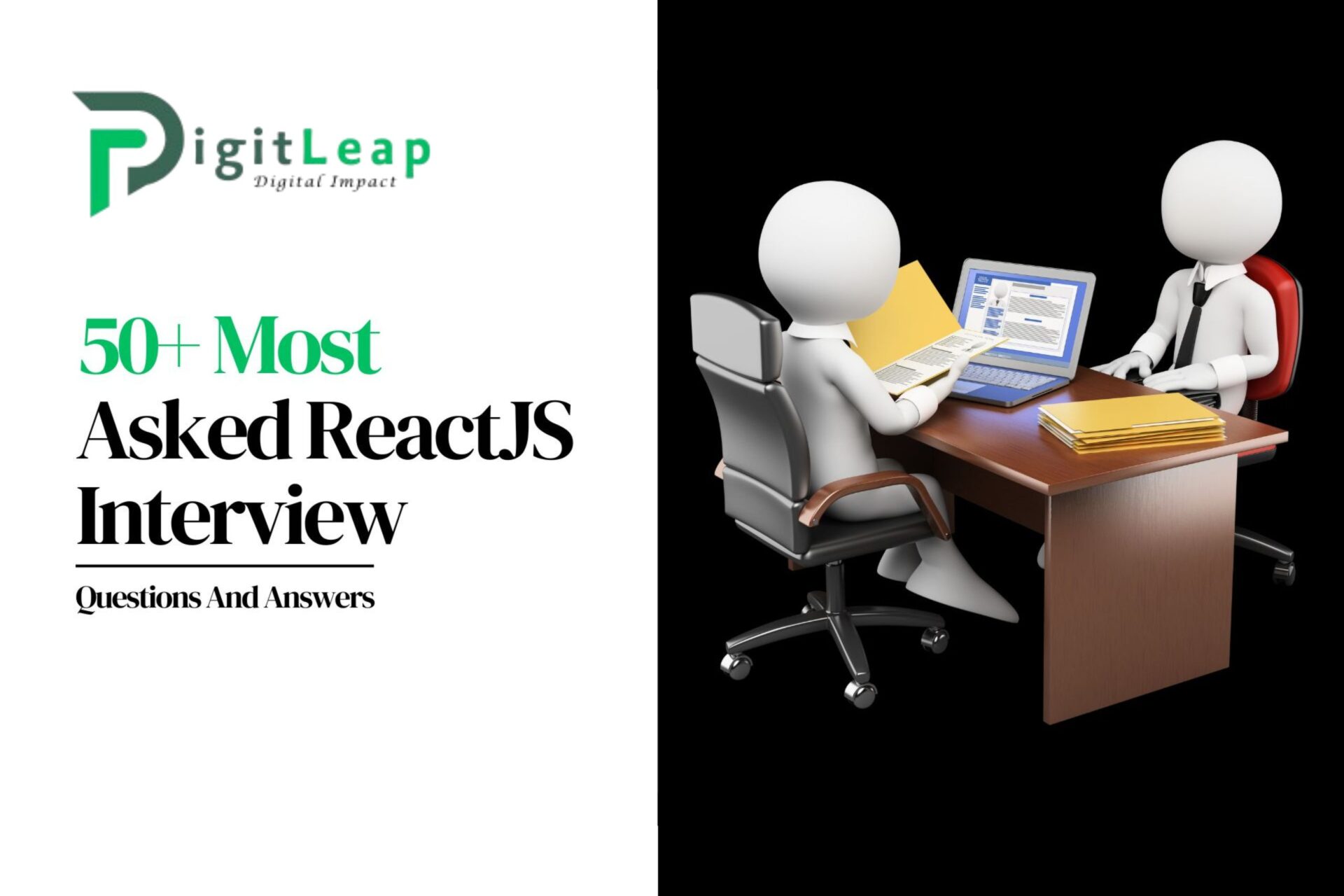50+ Most Asked ReactJS Interview Questions and Answers 2024
ReactJS continues to be a popular choice for building dynamic user interfaces. If you’re preparing for a ReactJS interview in 2024, here’s a comprehensive list of the most commonly asked questions, along with detailed answers.
1. What is ReactJS?
Answer:
ReactJS is a JavaScript library for building user interfaces, particularly single-page applications. It allows developers to create reusable UI components that efficiently update and render based on data changes.
2. What are the main features of ReactJS?
Answer:
Key features of ReactJS include:
- Component-based architecture
- Virtual DOM for performance optimization
- Declarative syntax
- Unidirectional data flow
- JSX (JavaScript XML) syntax
3. What is JSX?
Answer:
JSX stands for JavaScript XML. It is a syntax extension for JavaScript that allows writing HTML-like code within JavaScript. JSX makes it easier to create React elements and components with a more readable and concise syntax.
4. What is the Virtual DOM?
Answer:
The Virtual DOM is an in-memory representation of the real DOM elements. React updates the Virtual DOM first and then efficiently updates the actual DOM by comparing the changes, which improves performance.
5. How does ReactJS differ from other frameworks like Angular or Vue?
Answer:
ReactJS is a library focused on building UI components, while Angular and Vue are full-fledged frameworks that offer more built-in functionality. React emphasizes a component-based architecture and unidirectional data flow, whereas Angular uses two-way data binding and provides a comprehensive framework for building applications.
6. What is a React component?
Answer:
A React component is a reusable piece of UI that encapsulates rendering logic, state, and behavior. Components can be either class-based or functional, and they can be combined to build complex UIs.
7. What are the differences between class components and functional components?
Answer:
- Class Components: Use ES6 classes, have lifecycle methods, and can hold local state.
- Functional Components: Use functions, are simpler, and can use hooks for managing state and lifecycle features.
8. What are React Hooks?
Answer:
React Hooks are functions that allow you to use state and other React features in functional components. Some common hooks include useState, useEffect, and useContext.
9. What is useState hook?
Answer:
The useState hook allows functional components to manage local state. It returns an array with the current state and a function to update that state.
10. What is useEffect hook?
Answer:
The useEffect hook performs side effects in functional components, such as data fetching, subscriptions, or manually changing the DOM. It replaces lifecycle methods like componentDidMount and componentDidUpdate in class components.
11. What is the purpose of useContext hook?
Answer:
The useContext hook allows you to access the value of a React context without needing to pass props down through the component tree manually.
12. What are React Contexts?
Answer:
React Contexts provide a way to share values like themes, user information, or settings across components without explicitly passing them as props through every level of the component tree.
13. What is Redux?
Answer:
Redux is a state management library often used with React. It helps manage the global state of an application using a single store, actions, and reducers.
14. How does Redux work with React?
Answer:
Redux provides a global state that React components can connect to using react-redux library functions like connect and useSelector. Actions and reducers manage state changes and updates.
15. What are React Lifecycle Methods?
Answer:
Lifecycle methods are hooks that allow you to perform actions at specific points in a component’s lifecycle, such as componentDidMount, componentDidUpdate, and componentWillUnmount in class components.
16. How do you handle forms in React?
Answer:
Forms in React can be handled using controlled components, where form data is managed by React state, or uncontrolled components, where form data is handled by the DOM.
17. What is setState and how does it work?
Answer:setState is a method used in class components to update the component’s state. It schedules an update to the component’s state and re-renders the component with the new state.
18. What are PropTypes in React?
Answer:
PropTypes are a type-checking feature in React that allows you to define the expected data types and requirements for props passed to a component. They help ensure that components receive the correct types of data.
19. What is the difference between props and state in React?
Answer:
- Props: Immutable data passed from a parent component to a child component.
- State: Mutable data managed within a component that can change over time.
20. How do you optimize performance in a React application?
Answer:
Performance can be optimized in React applications using techniques like:
- Memoization (using
React.memoanduseMemo) - Lazy loading components
- Code splitting
- Avoiding unnecessary re-renders
21. What is React.memo?
Answer:React.memo is a higher-order component that memoizes a functional component to prevent unnecessary re-renders when the props haven’t changed.
22. What is Code Splitting in React?
Answer:
Code splitting is a technique where the application’s code is split into smaller chunks that are loaded on-demand. React provides lazy loading components to achieve code splitting.
23. What is React.lazy?
Answer:React.lazy is a function that dynamically imports a component. It enables code splitting by loading components only when they are needed.
24. What is Suspense in React?
Answer:Suspense is a component that wraps around components that use React.lazy. It allows you to handle the loading state by displaying a fallback UI while the lazy-loaded component is being fetched.
25. What is a Higher-Order Component (HOC)?
Answer:
A Higher-Order Component (HOC) is a function that takes a component and returns a new component with additional props or functionality. It’s used for code reuse and adding features to components.
26. What are render props?
Answer:
Render props is a pattern for sharing code between components by passing a function as a prop that returns a React element. This function can be used to control rendering based on state or logic.
27. What is the purpose of keys in React lists?
Answer:
Keys help React identify which items have changed, been added, or removed from a list. They should be unique among siblings to enable efficient updates and re-rendering of list items.
28. What is the role of shouldComponentUpdate?
Answer:shouldComponentUpdate is a lifecycle method that allows you to control whether a component should re-render based on changes in props or state. It helps optimize performance by preventing unnecessary renders.
29. What is componentDidCatch?
Answer:componentDidCatch is a lifecycle method in class components that handles errors that occur during rendering, in lifecycle methods, and in constructors of the whole tree below the component.
30. What are Fragments in React?
Answer:
Fragments are a way to group multiple elements without adding extra nodes to the DOM. They can be used with <React.Fragment> or the shorthand <>...</> syntax.
31. What is the difference between useEffect and useLayoutEffect?
Answer:
useEffect: Runs after the DOM has been painted. Suitable for side effects that don’t need to block the rendering.useLayoutEffect: Runs synchronously after DOM mutations, before the browser has a chance to paint. Useful for reading layout and synchronously re-rendering.
32. What is Context API and how does it work?
Answer:
Context API provides a way to pass data through the component tree without having to pass props down manually at every level. It consists of createContext, Provider, and Consumer components.
33. What are Hooks and how are they used in React?
Answer:
Hooks are functions that let you use state and other React features in functional components. Common hooks include useState, useEffect, and useContext.
34. What is useRef and how is it used?
Answer:useRef is a hook that returns a mutable ref object which persists for the full lifetime of the component. It is commonly used for accessing DOM elements directly or storing mutable values.
35. What is the difference between useReducer and useState?
Answer:
useState: Manages simple state logic within a component.useReducer: Manages more complex state logic by using a reducer function similar to Redux.
36. What is the purpose of React.StrictMode?
Answer:React.StrictMode is a tool for highlighting potential problems in an application. It activates additional checks and warnings for its descendants, like detecting unsafe lifecycle methods and deprecated APIs.
37. What are controlled components in React?
Answer:
Controlled components are form elements whose value is controlled by React state. Changes to the input value are handled by event handlers that update the state.
38. What are uncontrolled components in React?
Answer:
Uncontrolled components are form elements that handle their own state internally. The data is accessed using refs rather than state.
39. What is ReactDOM.render()?
Answer:ReactDOM.render() is a method used to render a React element into the DOM. It takes two arguments: the React element and the DOM container where the element should be rendered.
40. What are React Portals?
Answer:
React Portals allow you to render a child component into a DOM node that exists outside the parent component’s DOM hierarchy. Useful for modals, tooltips, and other UI elements that need to break out of their container.
41. What is useCallback hook?
Answer:useCallback is a hook that returns a memoized callback function. It’s useful for optimizing performance by preventing unnecessary re-creations of functions on every render.
42. What is useMemo hook?
Answer:useMemo is a hook that returns a memoized value. It’s used to optimize performance by caching expensive calculations and recalculating them only when dependencies change.
43. How does React handle event handling?
Answer:
React handles events using a synthetic event system that wraps the native DOM events. Event handlers are written in camelCase and are passed as props to components.
44. What is ReactDOM.hydrate()?
Answer:ReactDOM.hydrate() is used for server-rendered React applications. It attaches event listeners to the existing server-rendered HTML, instead of replacing it, which improves performance and SEO.
45. What are custom hooks in React?
Answer:
Custom hooks are user-defined functions that use built-in hooks to encapsulate and reuse logic across multiple components. They help share stateful logic without changing the component hierarchy.
46. What is useImperativeHandle hook?
Answer:useImperativeHandle is a hook that allows you to customize the instance value that is exposed when using ref with functional components. It is useful for exposing specific methods or properties to parent components.
47. How do you handle error boundaries in React?
Answer:
Error boundaries are components that catch JavaScript errors anywhere in their child component tree. They use componentDidCatch lifecycle method or getDerivedStateFromError to handle errors and display fallback UI.
48. What is the React.createElement function?
Answer:React.createElement is a function that creates a React element. It takes three arguments: the type of element (e.g., a string for HTML elements or a React component), props, and children.
49. How do you handle asynchronous operations in React?
Answer:
Asynchronous operations are handled in React using hooks like useEffect for data fetching and side effects, or using libraries like axios and fetch for API calls.
50. What are some common performance optimization techniques in React?
Answer:
Performance optimization techniques include:
- Code splitting using
React.lazyandSuspense - Memoization with
React.memoanduseMemo - Lazy loading images
- Avoiding unnecessary re-renders
- Using
useCallbackto memoize functions
This list covers the essential ReactJS interview questions and answers you need to know for 2024. Mastering these topics will help you prepare thoroughly for your interview and demonstrate your expertise in ReactJS.
Other Important Q&A List :
- OOPs Interview Questions And Answers
- SQL Interview Questions and Answers
- Content Writing Interview Questions and Answers
- Email Marketing Interview Questions and Answers
- Django Interview Questions and Answers
- C Programming Interview Questions and Answers
- ReactJS Interview Questions and Answers
- Angular Interview Questions and Answers
- Power BI Interview Questions and Answers
- Top DBMS Interview Questions and Answers
- Python Interview Questions and Answers
- MySQL Interview Questions and Answers
- Java Interview Questions and Answers
- Data Structures Interview Questions
- Flutter Interview Questions and Answers
- JavaScript Interview Questions and Answers
- PHP Interview Questions and Answers
- CSS Interview Questions and Answers
- HTML Interview Questions and Answers






